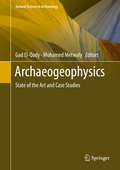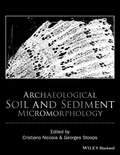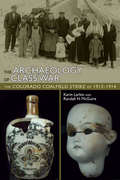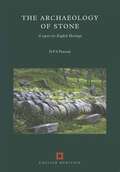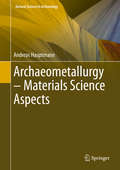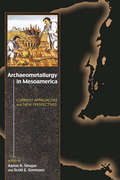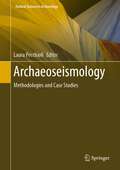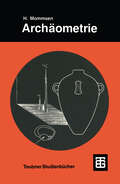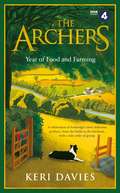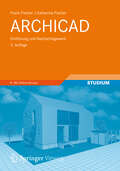- Table View
- List View
Arc Physics (Applied Physics and Engineering #8)
by M.F. HoyauxOn first acquaintance the electric arc discharge appears to be both visually attractive and a relatively simple phenomena to understand. To those of us engaged in prolonged study of this discharge, it remains a constantly exciting phenomena but we become only too aware of its complex nature and the difficulties in interpreting its bulk properties. This is particu larly true when the arc exists in a practical device and is subjected therefore to extreme conditions. In recent years the possibilities for the beginning of a fuller understanding of the complexities of the arc has arisen out of the excellent research and development work of scientists and engineers throughout the world. Much of this work has been stimulated not only by the need for the development of practical devices but also by the interest in thermonuclear fusion, mag netohydrodynamic generation and space exploration. In much of this work, the arc discharge has been a common feature as a source of study of high temperature plasma. As a result of this increased interest in the arc, the expert and would-be expert is now faced with the problem of assessing extensive newly published information on arc properties. Thus there is the need for texts which present to the engineer and researcher a review and summary of the present situation. This book is a valuable contribution to this task.
Arc Welding Processes Handbook
by Ramesh SinghWritten by a welding/metallurgical engineer with over 40 years of experience, Arc Welding Processes Handbook delivers the welding and materials expertise required to master complex welding processes and techniques to ensure that the task is done correctly and safely. While reinforcing an understanding of international welding standards and rules. The prefect handbook for those professionals who need an “up- to-date” reference to advance processes as well as those welders new to the field and need to hone their skills. Arc Welding Processes Handbook five-part treatment starts with a clear and rigorous exposition of the applications and equipment of Shielded Metal Arc Welding (SMAW) and Gas Tungsten Arc Welding (GTAW), followed by self-contained parts concerning processes applications and equipment for Gas Metal Arc Welding (GMAW), Flux Core Arc Welding (FCAW), and Submerged Arc welding (SAW). Case studies taken directly from the field are included to highlight each part of the handbook. An applied reference, each Part of Arc Welding Processes Handbook offersvaluable advice regarding the industry or industries where the process is commonly used as well as a description the equipment. The Handbook reaches deeply into the area of nondestructive testing and science. In addition, this Handbook discusses the challenges presented by a number of corrosion-resistant alloys (CRAs). Case studies are included throughout the reference to reinforce an understanding of how these processes were applied in the field and how they intersect with issues that may arise with equipment use and materials.
Arc Welding Processes Handbook
by Ramesh SinghWritten by a welding/metallurgical engineer with over 40 years of experience, Arc Welding Processes Handbook delivers the welding and materials expertise required to master complex welding processes and techniques to ensure that the task is done correctly and safely. While reinforcing an understanding of international welding standards and rules. The prefect handbook for those professionals who need an “up- to-date” reference to advance processes as well as those welders new to the field and need to hone their skills. Arc Welding Processes Handbook five-part treatment starts with a clear and rigorous exposition of the applications and equipment of Shielded Metal Arc Welding (SMAW) and Gas Tungsten Arc Welding (GTAW), followed by self-contained parts concerning processes applications and equipment for Gas Metal Arc Welding (GMAW), Flux Core Arc Welding (FCAW), and Submerged Arc welding (SAW). Case studies taken directly from the field are included to highlight each part of the handbook. An applied reference, each Part of Arc Welding Processes Handbook offersvaluable advice regarding the industry or industries where the process is commonly used as well as a description the equipment. The Handbook reaches deeply into the area of nondestructive testing and science. In addition, this Handbook discusses the challenges presented by a number of corrosion-resistant alloys (CRAs). Case studies are included throughout the reference to reinforce an understanding of how these processes were applied in the field and how they intersect with issues that may arise with equipment use and materials.
Arc Welding Qualification Standards: Fundamentals and Application (Synthesis Lectures on Welding Engineering)
by Darren BarborakThis textbook introduces the reader to the development and qualification of arc welding procedures and personnel to industry codes and standards. The mechanics of using welding standards, how to address their requirements, and their relationship with other standards are explained. The reader will gain a working knowledge of common welding standards including a review of welding processes variables, the inspection and testing of welds, and their acceptance criteria. The reader will develop a basic understanding of: Common arc welding standards Welding related documentation The welding procedure development & qualification process Essential, non-essential, & supplementary essential variables for arc welding processes The requirements for the inspection & testing of weld qualification coupons Purpose, intent, & compliance of a Welding Procedure Specifications (WPS) Purpose, intent, & compliance of a Procedure Qualification Records (PQR) The welder/operator performance qualification process Purpose, intent, & compliance of a Welder Performance Qualification Record (WPQR) This textbook was written for use in an undergraduate course in Welding Engineering Although the book is aimed at Welding Engineering students, it should also serve as a useful guide to other engineers, technicians, and specialists who are working in the field of welding and are seeking how to apply relevant codes and standards to qualify welding procedures and personnel. While the book focused primarily on the common arc welding processes using AWS B2.1 and ASME BPVC Section IX, the principles discussed will apply to most welding processes in general and most welding qualification standards.
ArcGIS Pro 3.x Cookbook: Create, manage, analyze, maintain, and visualize geospatial data using ArcGIS Pro
by Tripp Corbin, GISPLeverage the powerful tools in Esri's ArcGIS Pro to perform geospatial analysisKey FeaturesHarness the power of ArcGIS Pro to build informative maps showcasing your GIS dataAnalyze geospatial data through proximity, spatial statistics, and hotspot analysisIncrease data entry efficiency and quality with advanced geodatabase behaviorPurchase of the print or Kindle book includes a free PDF eBookBook DescriptionArcGIS Pro, Esri's newest desktop GIS application, offers powerful tools for visualizing, maintaining, and analyzing data. This cookbook will help existing ArcMap users transition to ArcGIS Pro and teach new users how to utilize its GIS tools effectively. You’ll learn how to create geodatabases, convert data formats, link tables from outside sources, edit 2D and 3D data, ensure data integrity with topology, and enable advanced geodatabase behavior. By the end, you'll be able to effectively use ArcGIS Pro as your primary desktop GIS application, maintaining, analyzing, and displaying data using common methods and tools.What you will learnNavigate the new ArcGIS Pro ribbon interfaceCreate and publish 2D and 3D mapsEdit data using standard tools and topologyLink data together using joins, relates, and relationship classesCreate a new geodatabase and validate data using domains, subtypes, attribute rules, and contingent valuesConvert data formats and project data to new coordinate systemsPerform proximity analysis and map clusters with hotspot analysisConduct advanced 3D analysis with 3D Analyst extensionWho this book is forThis book is for GIS professionals, architects, specialists, analysts, and technicians looking to learn how to use ArcGIS Pro and the powerful data editing, analysis, and creation tools it offers. Those who are just getting started with ArcGIS Pro and wish to expand their skills, as well as those who want to migrate to this platform will also find this book helpful. While some basic GIS experience is helpful, it’s not a prerequisite.
Arch Dams: Designing and Monitoring for Safety (CISM International Centre for Mechanical Sciences #367)
by Jose O. PedroThe present volume provides a comprehensive understanding of the modern criteria, models and methods of analysis of arch dams, for normal operation conditions and under exceptional loads. This information is important for all those involved in the evaluation of the behaviour and condition of arch dams and other large structures, either for design or monitoring purpose.
Archaeogeophysics: State of the Art and Case Studies (Natural Science in Archaeology)
by Gad El-Qady Mohamed MetwalyThis book describes the application of non-destructive geophysical methods in subsurface archaeological features. Such non-destructive methods are magnetometry, electrical resistance, electromagnetic conductivity, magnetic susceptibility and ground penetrating radar. This book also includes the last improvements in instrumentation, data processing, and interpretations of the collected data sets leading to the rapid progress in geophysical applications in the field of archaeological investigations. The book also provides complete case-studies and archaeological interpretation obtained our results carried out in different localities around the world.
Archaeological Landscape Evolution: The Mariana Islands in the Asia-Pacific Region
by Mike T. CarsonLandscapes have been fundamental to the human experience world-wide and throughout time, yet how did we as human beings evolve or co-evolve with our landscapes? By answering this question, we can understand our place in the complex, ever-changing world that we inhabit. This book guides readers on a journey through the concurrent processes of change in an integrated natural-cultural history of a landscape. While outlining the general principles for global application, a richly illustrated case is offered through the Mariana Islands in the northwest tropical Pacific and furthermore situated in a larger Asia-Pacific context for a full comprehension of landscape evolution at variable scales. The author examines what happened during the first time when human beings encountered the world’s Remote Oceanic environment in the Mariana Islands about 3500 years ago, followed by a continuous sequence of changing sea level, climate, water resources, forest composition, human population growth, and social dynamics. This book provides a high-resolution and long-term view of the complexities of landscape evolution that affect all of us today.
Archaeological Soil and Sediment Micromorphology
by Cristiano Nicosia Em. Prof. Dr. Georges StoopsArchaeological Soil and Sediment Micromorphology goes beyond a mere review of current literature and features the most up to date contributions from numerous scientists working in the field. The book represents a groundbreaking and comprehensive resource covering the plethora of applications of micromorphology in archaeology. Archaeological Soil and Sediment Micromorphology offers researchers, students and professionals a systematic tool for the interpretation of thin sections of archaeological contexts. This important resource is also designed to help stimulate the use of micromorphology in archaeology outside Europe, where the technique is less frequently employed. Moreover, the authors hope to strengthen the proper application of soil micromorphology in archaeology, by illustrating its possibilities and referring in several cases to more specialized publications (for instance in the field of plant remains, pottery and phytoliths). Written for anyone interested in the topic, this important text offers: Contributions from most of the world's leading authorities on soil micromorphology A series of chapters on the major topics selected among the most recurrent in literature about archaeological soil micromorphology Systematic descriptions of all important micromorphological features Special analytical tools employed on thin sections, such as SEM/EDS, image analysis, fluorescence microscopy, mass spectrometry, among others Numerous cross-references 400 illustrated full-colour plates The resource provides the most current and essential information for archaeologists, geoarchaeologists, soil scientists and sedimentologists. Comprehensive in scope, Archaeological Soil and Sediment Micromorphology offers professionals and students a much-needed tool for the interpretation of thin sections of archaeological contexts.
Archaeological Soil and Sediment Micromorphology
by Cristiano Nicosia Georges StoopsArchaeological Soil and Sediment Micromorphology goes beyond a mere review of current literature and features the most up to date contributions from numerous scientists working in the field. The book represents a groundbreaking and comprehensive resource covering the plethora of applications of micromorphology in archaeology. Archaeological Soil and Sediment Micromorphology offers researchers, students and professionals a systematic tool for the interpretation of thin sections of archaeological contexts. This important resource is also designed to help stimulate the use of micromorphology in archaeology outside Europe, where the technique is less frequently employed. Moreover, the authors hope to strengthen the proper application of soil micromorphology in archaeology, by illustrating its possibilities and referring in several cases to more specialized publications (for instance in the field of plant remains, pottery and phytoliths). Written for anyone interested in the topic, this important text offers: Contributions from most of the world's leading authorities on soil micromorphology A series of chapters on the major topics selected among the most recurrent in literature about archaeological soil micromorphology Systematic descriptions of all important micromorphological features Special analytical tools employed on thin sections, such as SEM/EDS, image analysis, fluorescence microscopy, mass spectrometry, among others Numerous cross-references 400 illustrated full-colour plates The resource provides the most current and essential information for archaeologists, geoarchaeologists, soil scientists and sedimentologists. Comprehensive in scope, Archaeological Soil and Sediment Micromorphology offers professionals and students a much-needed tool for the interpretation of thin sections of archaeological contexts.
Archaeology And Geographic Information Systems: A European Perspective
by Gary R. Lock Zoran StancicGeographic information systems GIS applications are viewed with increasing interest by the archaeology community and this book, with its diversity of topics and authorship, should be a useful resource. Complementing the volume "Interpreting Space" Taylor & Francis, 1990, which focused on North American archaeology, this title further develops themes within a specifically - though not exclusively - European context.; It is apparent that there are fundamental differences between North American and European archaeological uses of GIS. Primarily these differences lie in the types of evidence for past landscapes that are available for study in the two continents, and secondly in the different approaches to archaeology and specifically the theory and practice of landscape archaeology. This title centres on the role of archaeological theory in cultural resource management CRM and in GIS applications generally. It showcases the important debate which takes the emphasis away from the technology of GIS and places it back within the central concerns of archaeology and particularly European archaeology.; "Archaeology and GIS" includes material on such concerns as CRM applications, landscape archaeology, intra-site applications and explicitly theoretical concerns, thus representing the state of GIS applications in European archaeology. Contributions come from countries such as France, Italy, Hungary, UK, USA, the Netherlands, the Czech Republic, Spain, Slovenia and Finland.
Archaeology And Geographic Information Systems: A European Perspective
by Gary Lock Zoran StančičGeographic information systems GIS applications are viewed with increasing interest by the archaeology community and this book, with its diversity of topics and authorship, should be a useful resource. Complementing the volume "Interpreting Space" Taylor & Francis, 1990, which focused on North American archaeology, this title further develops themes within a specifically - though not exclusively - European context.; It is apparent that there are fundamental differences between North American and European archaeological uses of GIS. Primarily these differences lie in the types of evidence for past landscapes that are available for study in the two continents, and secondly in the different approaches to archaeology and specifically the theory and practice of landscape archaeology. This title centres on the role of archaeological theory in cultural resource management CRM and in GIS applications generally. It showcases the important debate which takes the emphasis away from the technology of GIS and places it back within the central concerns of archaeology and particularly European archaeology.; "Archaeology and GIS" includes material on such concerns as CRM applications, landscape archaeology, intra-site applications and explicitly theoretical concerns, thus representing the state of GIS applications in European archaeology. Contributions come from countries such as France, Italy, Hungary, UK, USA, the Netherlands, the Czech Republic, Spain, Slovenia and Finland.
Archaeology and Heritage of the Human Movement into Space (Space and Society)
by Beth Laura O’Leary P. J. CapelottiThis volume addresses the creation, documentation, preservation, and study of the archaeology of lunar, planetary, and interstellar exploration. It defines the attributes of common human technological expressions within national and, increasingly, private exploration efforts, and explore the archaeology of both fixed and mobile artifacts in the solar system and the wider galaxy.This book presents the research of the foremost scholars in the field of space archaeology and heritage, a recent discipline of the field of Space Archaeology and Heritage. It provides the emerging archaeological perspective on the history of the human exploration of space. Since humans have been creating a vast archaeological preserve in space and on other celestial bodies. This assemblage of heritage objects and sites attest to the human presence off the Earth and the study of these material remains are best investigated by archaeologists and historic preservationists. As space exploration has reached the half century mark, it is the appropriate time to reflect on the major events and technological development of this particular unique 20th century arena of human history.The authors encapsulate various ways of looking at the archaeology of both fixed and mobile human artifacts in the solar system. As missions continue into space, and as private ventures gear up for public and tourist visits to space and to the Moon and even Mars, it is the appropriate time to address questions about the meaning and significance of this material culture.
The Archaeology of Class War: The Colorado Coalfield Strike of 1913-1914
by Karin Larkin Randall H. McGuireThe Archaeology of the Colorado Coalfield War Project has conducted archaeological investigations at the site of the Ludlow Massacre in Ludlow, Colorado, since 1996. With the help of the United Mine Workers of America and funds from the Colorado State Historical Society and the Colorado Endowment for the Humanities, the scholars involved have integrated archaeological finds with archival evidence to show how the everyday experiences of miners and their families shaped the strike and its outcome.The Archaeology of Class War weaves together material culture, documents, oral histories, landscapes, and photographs to reveal aspects of the strike and life in early twentieth-century Colorado coalfields unlike any standard documentary history. Excavations at the site of the massacre and the nearby town of Berwind exposed tent platforms, latrines, trash dumps, and the cellars in which families huddled during the attack. Myriad artifacts—from canning jars to a doll’s head—reveal the details of daily existence and bring the community to life.The Archaeology of Class War will be of interest to archaeologists, historians, and general readers interested in mining and labor history.
An archaeology of innovation: Approaching social and technological change in human society (Social Archaeology and Material Worlds)
by Catherine J. FriemanAn archaeology of innovation is the first monograph-length investigation of innovation and the innovation process from an archaeological perspective. It interrogates the idea of innovation that permeates our popular media and our political and scientific discourse, setting this against the long-term perspective that only archaeology can offer. Case studies span the entire breadth of human history, from our earliest hominin ancestors to the contemporary world. The book argues that the present narrow focus on pushing the adoption of technical innovations ignores the complex interplay of social, technological and environmental systems that underlies truly innovative societies; the inherent connections between new technologies, technologists and social structure that give them meaning and make them valuable; and the significance and value of conservative social practices that lead to the frequent rejection of innovations.
An archaeology of innovation: Approaching social and technological change in human society (Social Archaeology and Material Worlds)
by Catherine J. FriemanAn archaeology of innovation is the first monograph-length investigation of innovation and the innovation process from an archaeological perspective. It interrogates the idea of innovation that permeates our popular media and our political and scientific discourse, setting this against the long-term perspective that only archaeology can offer. Case studies span the entire breadth of human history, from our earliest hominin ancestors to the contemporary world. The book argues that the present narrow focus on pushing the adoption of technical innovations ignores the complex interplay of social, technological and environmental systems that underlies truly innovative societies; the inherent connections between new technologies, technologists and social structure that give them meaning and make them valuable; and the significance and value of conservative social practices that lead to the frequent rejection of innovations.
The Archaeology of Stone: A report for English Heritage (English Heritage)
by D P PeacockEnglish Heritage's 'Exploring our past' (1991) identified stone in archaeology as a problem area: 'The sources, manufacture and distribution of stone artifacts remain poorly understood, whether these are the cutting tools of prehistory, such as axes and knives, or grinding implements such as hones and querns'. It further states that a commissioned assessment of stone in archaeology should identify basic recording standards, guidelines for processing, shortcomings in regional and local sequences, and potential themes for future study. 'The archaeology of stone' is the result of this commissioned report. Considering all types of stone other than flint, which is considered a special case, and using a combination of library work, site visits, and interviews with practitioners, Professor Peacock's report considers retention and processing policies, evaluates the needs of stone identification and provenancing, and examines ways of recording technological traces of stone working or use. In addition to stone axes, hones, and querns, a major area of concern is with building materials, where sheer quantities often overwhelm even the most smoothly run operations. In addition, consideration of standing buildings helps to put excavated material into a wider context. He concludes with recommendations that point to areas where more research and evaluation are needed, based firmly on the necessary condition that any changes to current practices must be demonstrably useful, and lead to a substantially better understanding of the past.
Archaeometallurgy – Materials Science Aspects (Natural Science in Archaeology)
by Andreas HauptmannThis book successfully connects archaeology and archaeometallurgy with geoscience and metallurgy. It addresses topics concerning ore deposits, archaeological field evidence of early metal production, and basic chemical-physical principles, as well as experimental ethnographic works on a low handicraft base and artisanal metal production to help readers better understand what happened in antiquity. The book is chiefly intended for scholars and students engaged in interdisciplinary work.
Archaeometallurgy in Global Perspective: Methods and Syntheses (PDF)
by Benjamin W. Roberts Christopher ThorntonThe study of ancient metals in their social and cultural contexts has been a topic of considerable interest in archaeology and ancient history for decades, partly due to the modern dependence on technology and man-made materials. The formal study of Archaeometallurgy began in the 1970s-1980s, and has seen a recent growth in techniques, data, and theoretical movements. This comprehensive sourcebook on Archaeometallurgy provides an overview of earlier research as well as a review of modern techniques, written in an approachable way. Covering an extensive range of archaeological time-periods and regions, this volume will be a valuable resource for those studying archaeology worldwide. It provides a clear, straightforward look at the available methodologies, including: •• Smelting processes •• Slag analysis •• Technical Ceramics •• Archaeology of Mining and Field Survey •• Ethnoarchaeology •• Chemical Analysis and Provenance Studies •• Conservation Studies With chapters focused on most geographic regions of Archaeometallurgical inquiry, researchers will find practical applications for metallurgical techniques in any area of their study. Ben Roberts is a specialist in the early metallurgy and later prehistoric archaeology of Europe. He was the Curator of the European Copper and Bronze Age collections at the British Museum between 2007 and 2012 and is now a Lecturer in Prehistoric Europe in the Department of Archaeology at the Durham University, UK. Chris Thornton is a specialist in the ancient metallurgy of the Middle East, combining anthropological theory with archaeometrical analysis to understand the development and diffusion of metallurgical technologies throughout Eurasia. He is currently a Consulting Scholar of the University of Pennsylvania Museum, where he received his PhD in 2009, and the Lead Program Officer of research grants at the National Geographic Society.
Archaeometallurgy in Global Perspective: Methods and Syntheses
by Benjamin W. Roberts Christopher ThorntonThe study of ancient metals in their social and cultural contexts has been a topic of considerable interest in archaeology and ancient history for decades, partly due to the modern dependence on technology and man-made materials. The formal study of Archaeometallurgy began in the 1970s-1980s, and has seen a recent growth in techniques, data, and theoretical movements. This comprehensive sourcebook on Archaeometallurgy provides an overview of earlier research as well as a review of modern techniques, written in an approachable way. Covering an extensive range of archaeological time-periods and regions, this volume will be a valuable resource for those studying archaeology worldwide. It provides a clear, straightforward look at the available methodologies, including: •• Smelting processes •• Slag analysis •• Technical Ceramics •• Archaeology of Mining and Field Survey •• Ethnoarchaeology •• Chemical Analysis and Provenance Studies •• Conservation Studies With chapters focused on most geographic regions of Archaeometallurgical inquiry, researchers will find practical applications for metallurgical techniques in any area of their study. Ben Roberts is a specialist in the early metallurgy and later prehistoric archaeology of Europe. He was the Curator of the European Copper and Bronze Age collections at the British Museum between 2007 and 2012 and is now a Lecturer in Prehistoric Europe in the Department of Archaeology at the Durham University, UK. Chris Thornton is a specialist in the ancient metallurgy of the Middle East, combining anthropological theory with archaeometrical analysis to understand the development and diffusion of metallurgical technologies throughout Eurasia. He is currently a Consulting Scholar of the University of Pennsylvania Museum, where he received his PhD in 2009, and the Lead Program Officer of research grants at the National Geographic Society.
Archaeometallurgy in Mesoamerica: Current Approaches and New Perspectives
by Aaron N. Shugar Scott E. SimmonsPresenting the latest in archaeometallurgical research in a Mesoamerican context, Archaeometallurgy in Mesoamerica brings together up-to-date research from the most notable scholars in the field. These contributors analyze data from a variety of sites, examining current approaches to the study of archaeometallurgy in the region as well as new perspectives on the significance metallurgy and metal objects had in the lives of its ancient peoples. The chapters are organized following the cyclical nature of metals--beginning with extracting and mining ore, moving to smelting and casting of finished objects, and ending with recycling and deterioration back to the original state once the object is no longer in use. Data obtained from archaeological investigations, ethnohistoric sources, ethnographic studies, along with materials science analyses, are brought to bear on questions related to the integration of metallurgy into local and regional economies, the sacred connotations of copper objects, metallurgy as specialized crafting, and the nature of mining, alloy technology, and metal fabrication.
Archaeoseismology: Methodologies and Case Studies (Natural Science in Archaeology)
by Laura PecchioliArchaeoseismic research provides data and information on past earthquakes but is limited by the lack of ongoing discussions about methodology. This volume is an interdisciplinary approach including archaeologists, geologists, geophysicists, seismologists, engineers, and architects from different countries to present a comprehensive recording and interpretation of ancient natural disasters on some case studies. The publication is an introduction to various aspects of the field of archaeoseismology for the knowledge of past seismicity, the reconstruction of the chronological history of a place, the interpretation and identification of seismic effects using different methods, etc. The collection provides an overview of research into archaeoseismology, making new contributions through innovative ideas on various topics. The publication can be an illustrative introduction to better understand the complexity of interpreting seismic effects on ancient and modern masonries, particularly for students with an open mind.
Archäometrie: Neuere naturwissenschaftliche Methoden und Erfolge in der Archäologie (Teubner Studienbücher Chemie)
by Hans MommsenThe Archers Year Of Food and Farming: A celebration of Ambridge’s most delicious produce, from the fields to the kitchens, with a side order of gossip
by Keri Davies'What's for tea, Clarrielove?' From the fabled kitchens of Ambridge come the recipes and gossip that fuel the nation's favourite village.Whether it's Susan's spicy chilli con carne on the hob or Helen's dramatic tuna bake in the oven, Jill's flapjacks stacked high or Alastair's Goan fish curry hotting up suppertime, this celebration of Ambridge life will take fans even closer to the heart of every Archers home.But this book isn't just a cook-along with our favourite families. It's full to the brim with tales and memories. The Archers Year of Food and Farming shares the ups and downs of the inhabitants of Ambridge and celebrates our countryside in all of its green and pleasant glory.Month-by-month, we learn more about the farming community and those big events in the Ambridge calendar: Shrove Tuesday and Easter, lambing, Open Farm Sunday, the village fete, Apple Day, the harvest, Stir-up Sunday and Deck the Hall.Rural traditions are alive and well in The Archers, but it's a contemporary world that is full of warmth, wit and the unexpected.
ARCHICAD: Einführung und Nachschlagewerk
by Frank Fischer Katharina FischerDie Autoren vermitteln einen problemlosen, einfachen Einstieg in die 3D-Architektursoftware ARCHICAD 15 in zwei Teilen. Teil 1: Der Leser startet mit einem Übungsprojekt, lernt dabei den Umgang mit ARCHICAD 15 und den wichtigsten Befehlen des Programms kennen. Der so gewonnene Überblick des wichtigsten Repertoires an Werkzeugen und Befehlen gibt Sicherheit zum Erstellen eigener Modelle. Teil 2: Das Nachschlagewerk bietet schnelle und erfolgreiche Hilfestellung beim Bearbeiten. Alle Befehle und Werkzeuge sind übersichtlich zusammengefasst. Die 3. Auflage wurde vollständig aktualisiert, ergänzt um die neuen Funktionen "Umbaufilter", "Schalen-Werkzeug", "Multidach".





